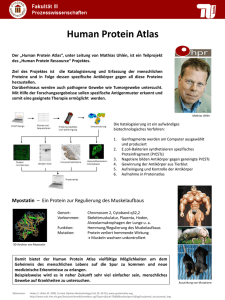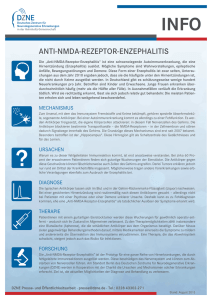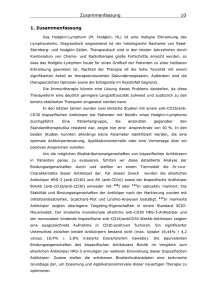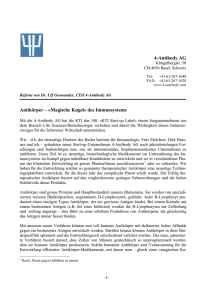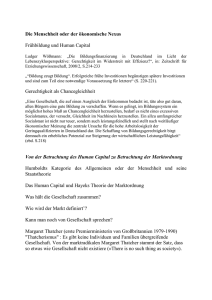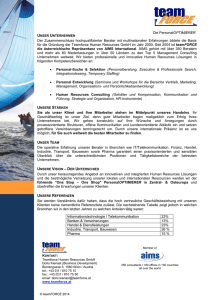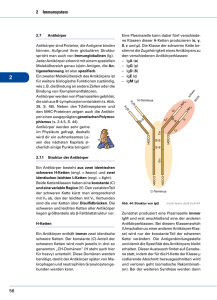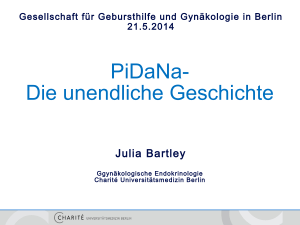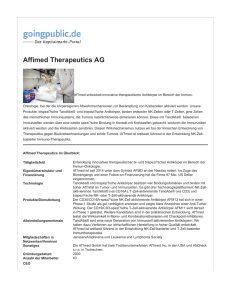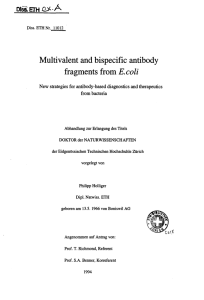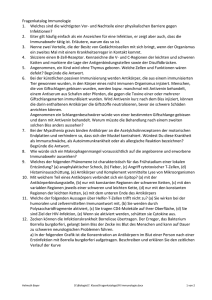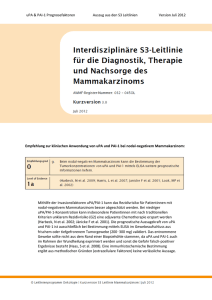Human monoclonal antibodies (mAbs) - ETH E
Werbung
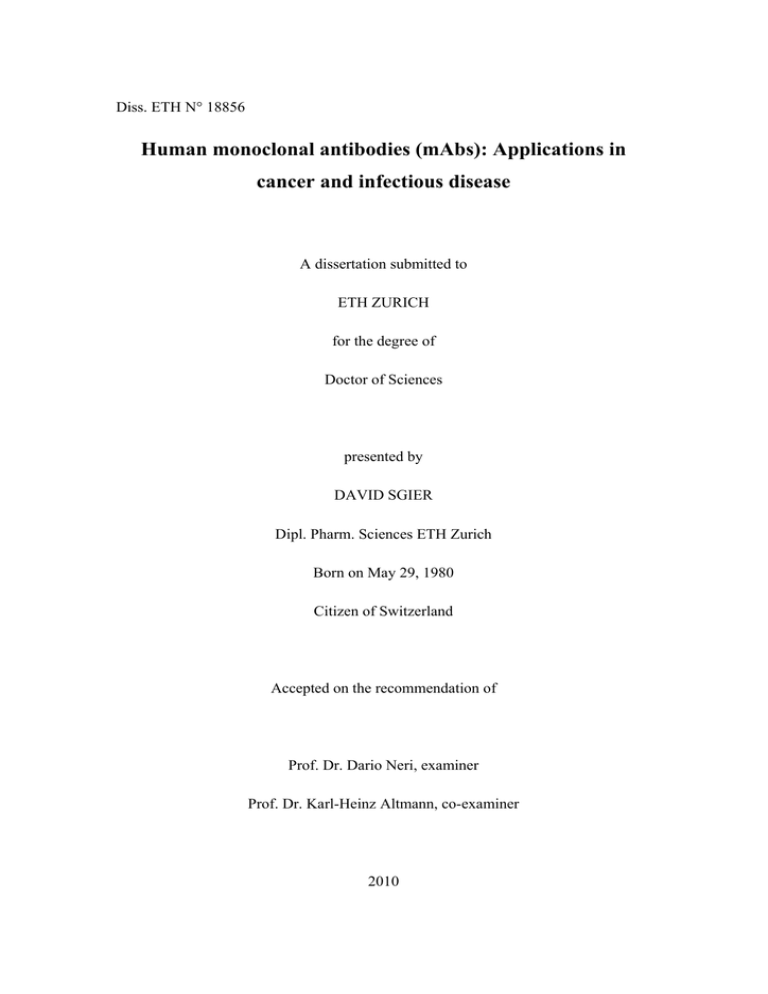
Diss. ETH N° 18856 Human monoclonal antibodies (mAbs): Applications in cancer and infectious disease A dissertation submitted to ETH ZURICH for the degree of Doctor of Sciences presented by DAVID SGIER Dipl. Pharm. Sciences ETH Zurich Born on May 29, 1980 Citizen of Switzerland Accepted on the recommendation of Prof. Dr. Dario Neri, examiner Prof. Dr. Karl-Heinz Altmann, co-examiner 2010 1 SUMMARY Monoclonal antibodies (mAbs) have proven to be useful as human protein therapeutics because they bind to drug targets with high affinity and specificity and exhibit a favorable pharmacokinetic profile. Phage display is a powerful and widely used technology for the isolation of mAbs. In this thesis we present the use of phage display for the isolation of monoclonal antibodies for therapeutic applications in cancer and infectious disease. The first part of the thesis describes the generation and affinity maturation of a human monoclonal antibody (termed DS2) against the human urokinase (uPA) capable of inhibiting its enzymatic activity with an IC50 value in the low nanomolar range. The novel antibody cross-reacts with murine uPA. It was expressed both as scFv fragment and in IgG format, allowing a systematic comparative immunofluorescence analysis of the uPA expression patterns in a large panel of human and murine tumors and of normal human tissue. While uPA was strongly expressed in virtually all tumor specimens tested, it only exhibited a weak expression in certain normal tissues (mainly in colon, lung, spleen and bone marrow). IgG(DS2) was not able to inhibit cancer growth in immunocompromised mice bearing subcutaneous human MDAMB-231 or DoHH-2 tumors. However, an ex vivo immunofluorescence analysis confirmed the ability of the DS2 antibody to preferentially localize at the tumor site compared to normal organs. Collectively, these data suggest that uPA blocking antibodies may not be indicated for cancer growth inhibition strategies, but may serve as valuable tools for the implementation of pharmacodelivery strategies against a variety of different tumors. The second part of the thesis describes the isolation, affinity maturation and characterization of a human monoclonal antibody (referred to as E7) specific to a mycolactone analogue PG-73. Mycolactone is a toxin involved in Buruli ulcer, a necrotizing skin disease caused by infection with Mycobacterium ulcerans. Mycolactone is secreted by the bacteria and is considered to have cytotoxic and immunosuppressive activities. Its mode of action is unclear, but in a guinea pig model of the disease, purified mycolactone injected subcutaneously reproduces the natural pathology, and mycolactone negative variants are avirulent, implying a key role for 1 9 the toxin in pathogenesis. The laboratory of K.H. Altmann synthesized the mycolactone analogue PG-73 containing the macrolide core structure of the native toxin. We successfully isolated a human monoclonal antibody specific to the PG-73 compound that allowed staining of M. ulcerans cultures in immunofluorescence and immunohistochemistry assays indicating the binding of the E7 antibody to the native mycolactone. The clone E7 is the first reported human monoclonal antibody specific to mycolactone. 1 10 2 ZUSAMMENFASSUNG Monoklonale Antikörper (mAbs) sind eine etablierte Klasse von therapeutischen Proteinen. Sie binden Zielmoleküle selektiv und mit hoher Affinität und zeichnen sich durch ein vorteilhaftes pharmakokinetisches Profil aus. Phage display ist eine nützliche und weit verbreitete Technologie für die Isolierung von mAbs. In dieser Doktorarbeit beschreiben wir die Anwendung von Phage display für die Isolierung von monoklonalen Antikörpern für den therapeutischen Einsatz in den Indikationsgebieten Onkologie und Infektionskrankheiten. Der erste Teil der Arbeit beschreibt die Generation und Affinitätssteigerung eines humanen Antikörpers (genannt DS2) gegen die humane Urokinase (uPA), der die Aktivität des Enzyms mit einem IC50-Wert im tiefen nanomolaren Bereich hemmt. Der neue Antikörper erkennt sowohl humanes als auch murines uPA. Er wurde sowohl als scFv Fragment als auch im IgG Format produziert und erlaubte eine systematische Immunfluoreszenzanalyse der uPA Expressionsprofile in einer Vielzahl von menschlichen und murinen Tumoren und gesundem menschlichem Gewebe. Während uPA in allen getesteten Tumoren stark exprimiert war, wurde nur in gewissen gesunden Geweben (hauptsächlich Colon, Lunge, Milz und Knochenmark) schwache Expression gefunden. Der Antikörper IgG(DS2) konnte das Wachstum von MDA-MB-231 und DoHH-2 Tumoren in immundefizienten Mäusen nicht hemmen. Aber eine ex vivo Immunfluoreszenzanalyse bestätigte die Eigenschaft des DS2 Antikörpers sich vornehmlich im Tumorgewebe und nicht in den gesunden Organen anzureichern. Diese Resultate legen nahe, dass uPA blockierende Antikörper weniger für die Hemmung von Tumorwachstum angezeigt sind, als mehr als wertvolle Werkzeuge für die Entwicklung von Drugdelivery-Strategien gegen verschiedene Tumore dienen können. Der zweite Teil dieser Doktorarbeit erörtert die Isolierung, Affinitätssteigerung und Charakterisierung eines humanen monoklonalen Antikörpers (genannt E7), der ein Mycolactone-Analog PG-73 spezifisch bindet. Mycolactone ist ein Toxin, das mit Buruli Ulkus in Verbindung gebracht wird, einer nekrotisierenden Hauterkrankung, die durch Infektion mit Mycobacterium ulcerans verursacht wird. Mycolactone wird von 1 den Bakterien sezerniert und steht im Verdacht, zelltoxische und 11 immunsupprimierende Wirkung zu haben. Der Wirkungsmechanismus ist nicht geklärt, doch in einem Meerschweinchenmodell der Krankheit, führen Injektionen von gereinigtem Mycolactone zu Buruli Ulkus-typischer Pathologie. Die Tatsache, dass Mycolactone-negative Bakterien avirulent sind, unterstützt die Hypothese einer Schlüsselrolle des Toxins in der Pathogenese von Buruli Ulkus. Das Labor von Professor K.H. Altmann hat das Mycolactone-Analog PG-73 hergestellt, das die komplette Macrolid-Kernstruktur des natürlichen Giftstoffes enthält. Es ist uns gelungen, einen humanen monoklonalen Antikörper zu isolieren, der PG-73 spezifisch bindet. Der neue Antikörper färbte M. ulcerans Kulturen in Immunfluoreszenz- und Immunhistochemie-Experimenten, was vermuten lässt, dass der E7 Antikörper das native Mycolactone erkennt. Der Antikörperklon E7 ist der erste beschriebene monoklonale Antikörper gegen Mycolactone. 1 12
